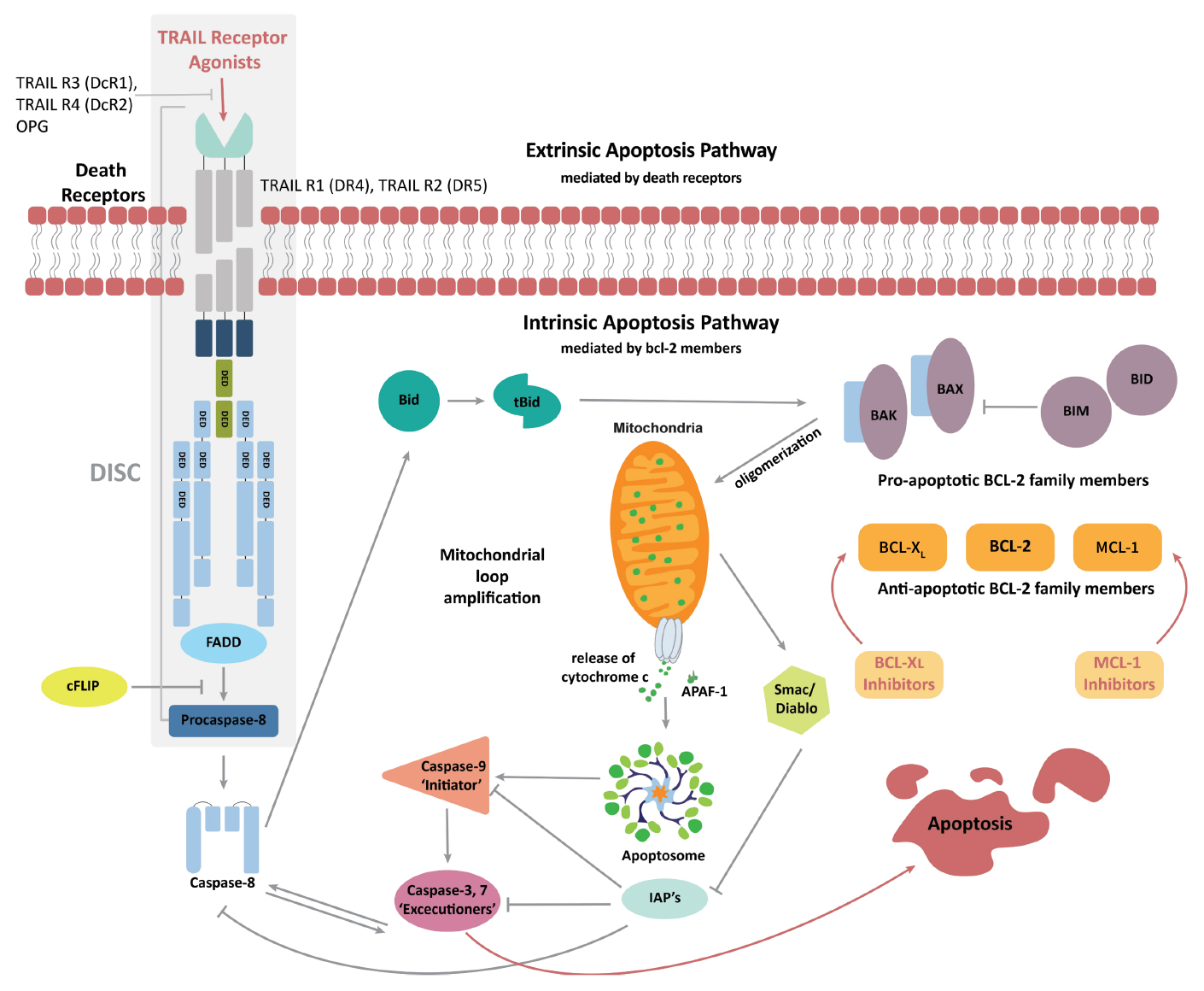BCL-XL
OVERVIEW
BCL-XL, and more generally the BCL-2 family members, are not only key regulators of apoptosis, but also actively participate in the regulation of other vital cellular functions.1
- The BCL-2 family is composed of anti- and pro-apoptotic proteins that function to regulate the intrinsic pathway of apoptosis.2,3
- BCL-XL and BCL-2 have overlapping but non-redundant anti-apoptotic function that confers resistance to multiple chemotherapy agents when tested in experimental systems. Over-expression of either protein is associated with poor prognosis in many human cancers.7
- BCL-XL and BCL-2 are paralogues that inhibit apoptosis elicited by a wide variety of stimuli that play critical roles in cancer development and resistance to treatment.7
- BCL-XL and BCL-2 can differ substantially in the potency with which they inhibit apoptosis, mediated in part by differences in the inhibition of specific subcellular pathways7
- Many clinical studies have indicated that expression of these anti-apoptotic proteins in tumors is associated with poor prognosis7
BCL-XL and the Intrinsic Apoptosis Pathway
(Adapted from Goncharenko-Khaider N, et al. (February 27th 2013), IntechOpen, DOI: 10.5772/53380. http://creativecommons.org/licenses/by/3.0/ for CC BY 3.0)
IMPLICATIONS IN CANCER
- BCL-XL is frequently overexpressed, compared with normal tissue counterparts, in a significant subset of common cancers.6
- BCL-XL regulates not only cell fate determination (i.e. apoptosis), but also pathways involved in the progression of tumors including melanoma, glioblastoma, pancreatic neuroendocrine and breast tumors.6
- In addition, combined targeting of JAK2 and BCL-2/BCL-XL is able to circumvent and overcome acquired resistance to single-agent JAK2 inhibitor treatment in preclinical models.8,9
- BCL-XL is implicated as a major survival factor in ruxolitinib-naïve and ruxolitinib-treated, relapsed/refractory myelofibrosis patients.10
Oncogenic Expression
In vitro models have shown BCL-XL overexpression increases in vitro cell migration and invasion and facilitates tumor cells to form de novo vasculogenic structures. Furthermore, BCL-XL overexpressing cells exhibit higher tumors sphere formation capacity and express higher levels of stem cell markers, supporting the concept that BCL-XL plays essential roles in the maintenance of cancer stem cell phenotype.1
Related Research
- Trisciuoglio D, et al. BCL-XL overexpression promotes tumor progression-associated properties. . Cell Death & Disease. 2017;8:3216.
- Cory S, Huang DC, Adams JM. The Bcl-2 family: roles in cell survival and oncogenesis. Oncogene. 2003;22:8590-8607.
- Plati J, Bucur O, Khosravi-Far R. Apoptotic cell signaling in cancer progression and therapy. Integr Biol (Camb). 2011;3:279-296.
- Trudel S, Stewart AK, Li Z, et al. The Bcl-2 family protein inhibitor, ABT-737, has substantial antimyeloma activity and shows synergistic effect with dexamethasone and melphalan. Clin Cancer Res. 2007;13(2):621-629.
- Davids MS, Letai A. Targeting the B-cell lymphoma/leukemia 2 family in cancer. J Clin Oncol. 2012;30(25):3127-3135.
- Adams JM, Cory S. The Bcl-2 apoptotic switch in cancer development and therapy. Oncogene. 2007;26:1324-1337.
- Fiebig AA, et al. Bcl-XL is qualitatively different from and ten times more effective than Bcl-2 when expressed in a breast cancer cell line. BMC Cancer. 2006;6:213.
- Waibel M, et al. Combined Targeting of JAK2 and Bcl-2/Bcl-xL to Cure Mutant JAK2-Driven Malignancies and Overcome Acquired Resistance to JAK2 Inhibitors. Cell Rep. 2013; 5(4):1047–1059.
- Zhang M, et al. Selective targeting of JAK/STAT signaling is potentiated by Bcl-xL blockade in IL-2–dependent adult T-cell leukemia. Proc Natl Acad Sci U S A. 2015;112(40):12480–12485.



